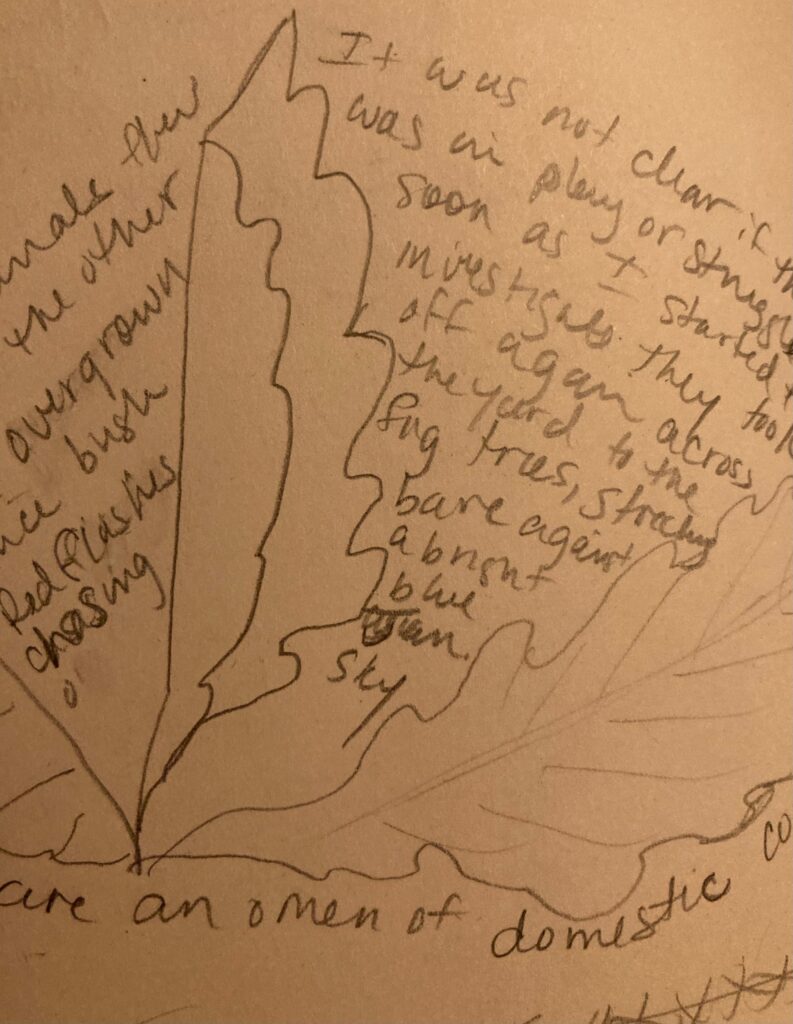
By Brandy Renee McCann
My partner observed me struggling through a tutorial on botanical drawing and asked, “Why draw when you can take a picture?”. I looked at the potted aloe plant in front of me and compared it to my drawing. There was a resemblance, but it is safe to say that sketching isn’t my strong suit.
I shrugged, unable to answer my partner’s sensible question. I felt that my memoir, which is focused on the natural world, could benefit from visuals; but I could not envision a way to use photography to convey the intimacy I want to invoke. I want the sections where I discuss particular plants to feel more like a Renaissance-era herbal text that feature line drawings. But I knew there was another reason though I was unable to name it. A few days later the answer came while in Janisse Ray’s Nature Journaling Group.
Nature journals, as a genre, employ drawings of flora, fauna, landscape and the like alongside text as a way to deepen one’s experience with the natural world. I realized this idea is familiar to me as a social scientist who routinely sketches models to help me think about relationships between concepts.

In my day job I am part of a team who investigates how dementia impacts families, with a particular focus on care partners. Care partners are family members who help someone with a dementia diagnosis navigate everyday tasks from managing medications to ensuring bills are paid to, typically later in the disease progression, helping with bathing and dressing. Family care partners report that as symptoms become more noticeable, they feel like they are vigilant or “on duty” at all times. I got curious about these feelings of vigilance and whether or not having paid helpers gave care partners relief from feeling on duty.
I drew a simple picture of my curiosity. My common-sense hunch was that care partners would experience less vigilance (downward arrow) at times when they had more help (upward arrow). However, my data revealed that my hunch did not have much basis in the lived experience of the care partners. In fact, for a variety of reasons, such as lack of trust, frequent unexpected disruptions, it often happened that having help provoked more feelings of vigilance. So I went back to my sketch pad, only this time my picture was considerably more complex than two arrows moving in opposite directions.
Rosemary Daniell, author and founder of the Zona Rosa writers’ groups, says that along with keeping journals filled with ideas, dreams, bits of dialog and so forth, she also includes drawings. She says, “I had learned that making pictures of my conflicts, however rudimentary, was an aid toward resolving them.” And I realized that “process” was my missing reason: drawing helps me find direction, literally shapes the contours of an idea during revision. If those drawings are good enough to include in the final text, then all the better.
Both creating and gazing at visual representations of ideas and events can access the unconscious and open up new possibilities as a writer and reader. Hildegard of Bingen, who was a Medieval scholar, abbess, and creative, influenced the likes of Carl Jung with her mandala-like iconography that illustrate her radical theology. Jung argued that these artforms tap into ancient ways of understanding that are difficult to conceptualize with words.
In more contemporary times, The Trampoline Series by Appalachian writer, Robert Gipe, includes what were originally his manuscript doodles as illustrations in the novel series. These drawings interrupt the text in Trampoline, which tells the story of Dawn, a teenager whose mother struggles with addiction and whose place has been marred by coal mining. Like the popular novel it anticipates, Demon Copperhead by Barbara Kingsolver, Gipe’s content is emotionally hard to read despite Dawn’s plainspokenness. Gipe’s illustrations, however, give the reader a moment of pause, to empathize and feel the grief that infuses the story. Whether producing or consuming an image, or drawing in the margins of a book, contouring the shapes of a story is a valuable tool in digesting complex material. In late morning, with the sun’s rays streaming through my attic bedroom window, I snuggle up in a mattress on the floor with my sketchbook and a red mechanical pencil. I sketch possibilities and shade inside the outlines until my pencil strokes form phrases and paragraphs and transfigure bright, empty pages into the shape of meaning.

More resources from Wind & Root editor Charlotte Hamrick:
Jill Hess’s Notes substack: https://jillianhess.substack.com/
Emma Mitchell’s work: https://emmamitchell.net/books

Brandy Renee McCann
Brandy Renee McCann, PhD is a writer and social scientist whose work is focused on life in Appalachia. Her creative work has been published in Reckon Review, Still: The Journal, Change Seven, Pine Mountain Sand & Gravel, The Dead Mule, and other literary venues. Brandy’s scholarly, collaborative work on aging in Appalachia can be found in a variety of peer-reviewed journals including the Journals for Gerontology: Social Sciences, Journal of Rural Mental Health, and Journal of Family Issues among others. Brandy is a research associate and project coordinator at the Center for Gerontology at Virginia Tech. To learn more about the family caregiving research in which she’s currently involved, visit here: https://careex.isce.vt.edu. Her social media handle is appalbrandy.
